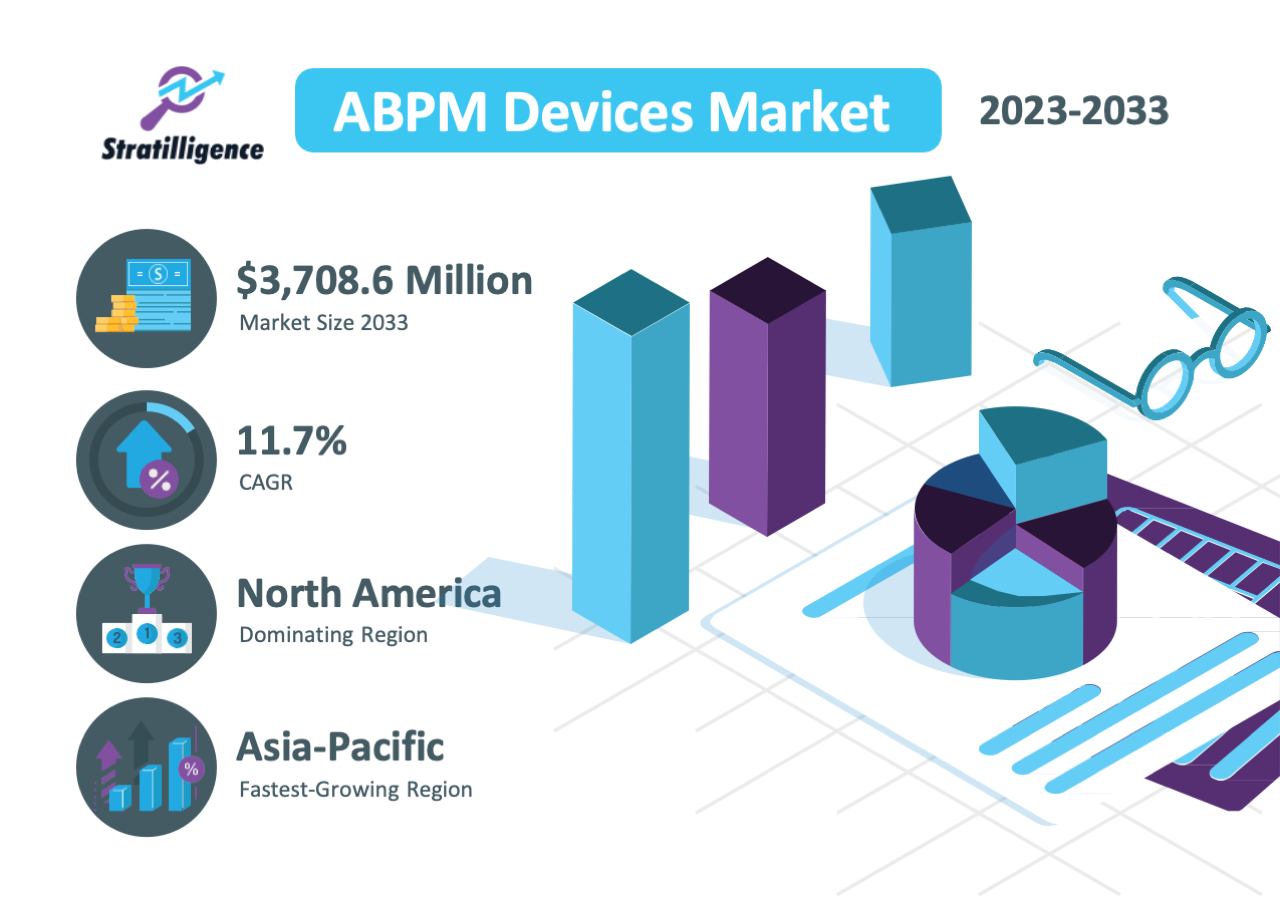Follow Us :
Ambulatory Blood Pressure Monitoring Devices Market Report: Size, Share, Trends, and Forecast (2024-2033) – By Product, Distribution Channel, and End-users
- Report ID: STAR6224
- Industry: Healthcare & Life Sciences
- Published Date: 11-01-2025
- NUMBER OF PAGES: 229
- FORMAT:
Ambulatory Blood Pressure Monitoring Devices Market Research: 2033
The global ambulatory blood pressure monitoring devices market size was valued at $1,225 million in 2023 and is projected to reach $3,708.6 million by 2033, growing at a CAGR of 11.7% from 2024 to 2033.
Ambulatory Blood Pressure Monitoring (ABPM) devices are designed to measure blood pressure over an extended period. They are worn by patients during their daily activities, allowing for continuous tracking of blood pressure fluctuations in real-life settings.
The ambulatory blood pressure monitoring devices market focuses on the sale and use of devices that track a person’s blood pressure over a 24-hour period or more. Unlike traditional blood pressure checks, which only provide a single reading at a specific time, ABPM devices allow for continuous monitoring throughout the day and night while the patient continues with normal daily activities.
This continuous monitoring is particularly valuable for detecting conditions such as white-coat hypertension, where blood pressure spikes only occur in medical settings, or for observing fluctuations that might be missed during a routine checkup. The devices typically consist of either wrist or arm-based monitors that automatically measure and record blood pressure at regular intervals.
The foremost customers of these gadgets encompass hospitals, clinics, ambulatory care centers, and individuals using them at home for private fitness tracking. With the growing instances of hypertension and the developing cognizance of preventative healthcare, the demand for ABPM gadgets is predicted to upward thrust substantially in the coming years. These gadgets offer crucial facts to help diagnose and control various cardiovascular conditions, main to better, more knowledgeable remedy plans.
The Ambulatory Blood Pressure Monitoring (ABPM) devices market is growing rapidly, driven by advancements in healthcare technology and rising demand for effective hypertension monitoring solutions. ABPM devices, including Wrist ABPM Devices, Arm ABPM Devices, and Wearable Blood Pressure Monitors, provide essential out-of-office BP readings that offer continuous insights into a patient’s blood pressure beyond clinical settings.
These cuff-based blood pressure devices enable precise continuous BP monitoring, helping detect fluctuations and nocturnal hypertension more effectively. As part of comprehensive patient monitoring solutions, ABPM devices are vital in managing cardiovascular risks and guiding treatment decisions. With a growing focus on proactive healthcare, ABPM devices are becoming crucial in both clinical and home environments for reliable, round-the-clock blood pressure assessment.

Key Market Drivers and Growth Factors in the Ambulatory Blood Pressure Monitoring Devices Market
The growth of the ambulatory blood pressure monitoring devices market is pushed via numerous key factors. The rising occurrence of high blood pressure and cardiovascular diseases globally has accelerated the need for continuous blood stress monitoring. Additionally, there’s developing attention approximately the importance of early prognosis and lengthy-term control of hypertension, which is boosting demand for ABPM gadgets.
Technological advancements have additionally made those devices more user-pleasant and correct, encouraging adoption in each clinical settings and domestic care. Furthermore, the rise in healthcare expenditure and the shift in the direction of preventive healthcare are playing a massive role in market growth.
Moreover, there is an ongoing ambulatory blood pressure monitoring devices market share owing to the increasing demand for continuous BP monitoring and advancements in healthcare technology.
The growing of hypertension instances around the world is a key purpose for the developing demand for Ambulatory Blood Pressure Monitoring devices. The World Health Organization (WHO) estimates that around 1.28 billion adults aged 30 to 79 have hypertension. This highlights the vital need for effective monitoring gear. Continuous blood stress monitoring is important for managing hypertension because it allows healthcare carriers to make informed selections based totally on correct readings taken through the years.
Coverage of the report
| Scope | Details |
|---|---|
| Market Size Estimation | Quantitative Insights: Market size and projections from 2019 to 2033, Market Size Units: USD Million |
| Market Dynamics | Analysis of drivers, restraints, and market trends shaping the ambulatory blood pressure monitoring devices market |
| Industry Analysis | Value chain analysis, Profit margin analysis, and Industry Overview |
| Segmentation | Product (Arm ABPM devices and Wrist ABPM devices), by Distribution Channel (Online Sales, Retail Pharmacies, and Medical Supply Stores), by End-users (Hospital, Ambulatory Surgical Centres, and Others) |
| Region Insights | Detailed analysis for North America, Europe, Asia-Pacific, Latin America, MEA with key countries in each region |
| Competitive Analysis | Company profiles, Ranking/Market share analysis, Competitive structure, Product differentiation |
| Customer Landscape Analysis | In-depth understanding of customer industry, preferences, and buying patterns |
| Supplier Analysis | Comprehensive analysis of suppliers |
Key Benefits for Stakeholders
This comprehensive report provides stakeholders with in-depth qualitative and quantitative analyses, focusing on the global Ambulatory Blood Pressure Monitoring Devices Industry from 2023 to 2033.
Key benefits include:
- Insightful Ambulatory Blood Pressure Monitoring Devices Market Forecast: The report offers detailed projections, covering various segments, current trends, and market dynamics.
- Competitive Analysis with Porter’s Five Forces: A thorough examination of the bargaining power of buyers and suppliers, the threat of new entrants, competitive rivalry, and substitute products.
- Comprehensive Market Overview: Gain access to crucial information about key market drivers, restraints, and opportunities.
- Regional and Country-Level Mapping: The report maps out major regions and countries based on their revenue contribution to the global market.
- Market Player Positioning: The competitive landscape analysis provides a clear understanding of the current market positioning of key players.
Technological Advancements in Ambulatory Blood Pressure Monitoring Devices Market
Technological innovations are drastically improving the functionality and enchantment of ambulatory blood pressure monitoring devices. Developments including wearable blood strain monitors, which encompass wrist and arm ABPM gadgets, offer patients greater comfort and simplicity of use. These gadgets are increasingly more designed for non-stop blood stress tracking, offering out-of-office readings that may be crucial for effective hypertension control. Furthermore, improvements in healthcare technology, including the combination of mobile packages and records analytics, are permitting better patient tracking answers, encouraging more healthcare companies to adopt these technologies.
Key products in the ambulatory blood pressure monitoring devices industry include wrist ABPM devices and arm ABPM devices, which offer patients more flexibility and comfort for hypertension monitoring. Similarly, the growing popularity of wearable blood pressure monitors allows for more accurate out-of-office BP readings, making it easier to track blood pressure patterns over time. These cuff-based blood pressure devices are integral to modern patient monitoring solutions, helping healthcare professionals better manage hypertension and other cardiovascular conditions.
Challenges and Restraints in the Ambulatory Blood Pressure Monitoring Devices Market
In the ambulatory blood pressure monitoring devices market, the key restraint factor is the high price of ABPM devices in comparison to conventional blood stress video display units, which may also restrict their adoption in low- and middle-income regions. Additionally, reimbursement problems in some countries can create obstacles for patients seeking to use ABPM devices, as insurance coverage for these devices is not always readily available. Another restraint lies in affected patient compliance, as wearing a device for twenty-four hours may be uncomfortable, leading some patients to avoid using it.
Furthermore, technological limitations in connectivity and data integration in older version models can prevent adoption, especially as healthcare systems increasingly rely on seamless digital answers. Lastly, the lack of awareness amongst healthcare providers and patients about the advantages of ABPM over general blood strain monitors could slow down the market’s growth.
Ambulatory Blood Pressure Monitoring Devices Market Segmentation
The ambulatory blood pressure monitoring devices market is bifurcated based on product, distribution channel, and end user.
By product, the market is categorized into Arm ABPM devices and Wrist ABPM devices. In 2023, the Arm ABPM devices segment holds the largest share in the Ambulatory Blood Pressure Monitoring (ABPM) Devices Market. Arm ABPM devices are generally more accurate and consistent in measuring blood pressure compared to wrist devices, which can be more affected by arm positioning and body movement. Clinicians and patients often prefer the accuracy that arm monitors provide.
By distribution channel, it is segmented as online sales, retail pharmacies, and medical supply stores. In 2023, the medical supply stores segment likely holds the largest share in the distribution channel for the Ambulatory Blood Pressure Monitoring (ABPM) devices market. Medical supply stores are often the preferred channel for healthcare providers and institutions, as they can directly access certified and regulated devices needed for clinical use. These stores frequently offer guidance on device selection, training, and setup, which adds value for both clinicians and patients.
Based on end-users, the market is divided into hospitals, ambulatory surgical centres, and others. The hospital segment is the largest end-user segment in 2023. Hospitals have a high influx of patients, particularly those with chronic conditions like hypertension, requiring continuous monitoring. This demand drives the need for a large number of ABPM devices in hospital settings.
Regional Analysis of the Global Ambulatory Blood Pressure Monitoring Devices Market
The ambulatory blood pressure monitoring devices market analysis is conducted region-wise across North America (the U.S. and Canada), Europe (UK, France, Germany, Italy, and the Rest of Europe), Asia-Pacific (China, Japan, India, South Korea, and the Rest of Asia-Pacific), Latin America (Brazil, Mexico, Argentina, and the Rest of Latin America), and MEA (Saudi Arabia, UAE, Kenya, South Africa, and the Rest of the Middle East & Africa).
Competition Analysis
The major players profiled in the ambulatory blood pressure monitoring devices market report having significant market share included are Baxter International Inc., Bosch+Sohn GmbH Co KG, BPL Ltd, Contec Medical Systems Co., Ltd, GE Healthcare, Halma Plc, Omron Corporation, OSI Systems Inc. (Spacelabs Healthcare Inc.), Schiller AG, and Vaso Corporation.
Key Developments/ Strategies in Ambulatory Blood Pressure Monitoring Devices Market
Major companies in the ambulatory blood pressure monitoring devices market outlook have adopted product launch, partnership, business expansion, and acquisition as their key developmental strategies to offer better products and services to customers in the market that is contributing towards ambulatory blood pressure monitoring devices market growth.
- In 2024, Biobeat launched a modern cuffless ABPM device. This wearable technology permits non-stop monitoring of blood strain and other cardiac metrics outside clinical settings. The device features an intuitive setup for patients, measuring important symptoms through a disposable wearable chest screen. Clinical studies have verified its efficacy, demonstrating similar performance to traditional.
- In 2024, Welch Allyn, a subsidiary of Hillrom, introduced a new mobile ABPM tool. It is designed for smooth use in both scientific and home settings, facilitating remote patient monitoring. This aligns with the growing trend towards home healthcare solutions.
To explore the complete range of topics and critical insights our report offers, including comprehensive chapter names and pivotal sections, we invite you to submit a request for a detailed sample. Your inquiry will help gain an in-depth perspective on the report’s valuable content.
Chapter 1: Executive Summary
-
- Overview of the report
- Key findings and insights
- Market Entry Strategy (Add-on)
- Strategic Recommendation
Chapter 2: Introduction
Chapter 3: Market Overview
Chapter 4: Ambulatory Blood Pressure Monitoring Devices Market, by Product
Chapter 5: Ambulatory Blood Pressure Monitoring Devices Market, by Distribution Channel
Chapter 6: Ambulatory Blood Pressure Monitoring Devices Market, by End-users
Chapter 7: Ambulatory Blood Pressure Monitoring Devices Market, by Region
Chapter 8: Ambulatory Blood Pressure Monitoring Devices Market, by Country
Chapter 9: Customer Industry Analysis (Add-on)
-
- Price Sensitivity Analysis
- Purchase Criteria Analysis
- XX
- XX
- XX
- XX
- XX
- XX
- XX
- XX
- XX
Chapter 10: Suppliers Analysis (Add-on)
-
- Industry Structure Analysis
- Switching Cost Analysis
- XX
- XX
- XX
- XX
- XX
Chapter 11: Competitive Landscape
Chapter 12: Company Profiles
